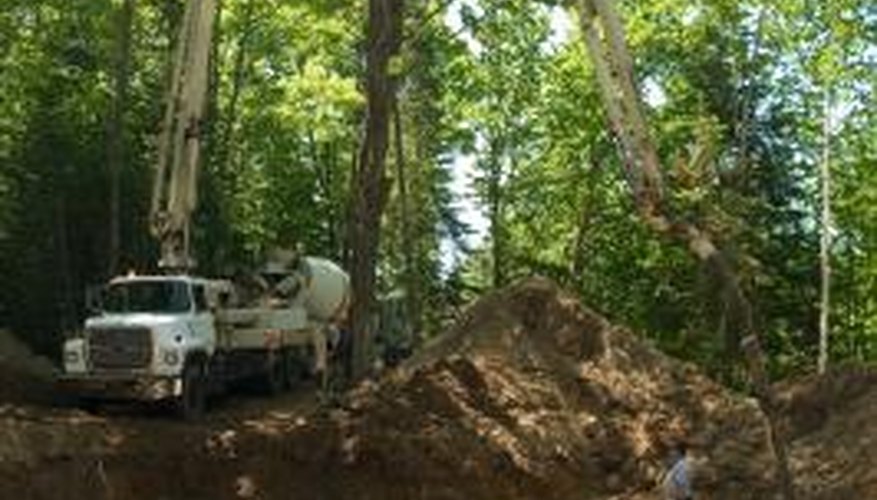If you're pouring a large concrete slab or have only a small team of helpers, dividing the slab into sections will give you more control of the pour and result in a more stable slab. Each section that you pour will be a separate slab surrounded by expansion joints on all sides. The expansion joint releases tension, preventing cracks from forming when concrete expands and contracts with temperature fluctuations.
Prepare the pour site by excavating six inches deep plus the thickness of your slab with a shovel or excavator machine. Level the floor of the site and compact the subgrade with a plate compactor machine. Compacting the soil forces out air pockets, stabilising the ground for the foundation.
Add six inches of 3/4-inch aggregate over the surface and compact it until the aggregate doesn't shift beneath your feet. Lay wire mesh over the aggregate to further support the foundation.
- If you're pouring a large concrete slab or have only a small team of helpers, dividing the slab into sections will give you more control of the pour and result in a more stable slab.
- Add six inches of 3/4-inch aggregate over the surface and compact it until the aggregate doesn't shift beneath your feet.
Arrange form timbers on their sides against the interior walls of the expanse. Place a timber along every side of the site and attach them together at the ends with a hammer and nails. The top of your forms marks where the surface of the concrete will be. Use 2-by-6 inch timbers for a 6-inch slab, or 2-by-4s for a 4-inch slab.
Set steel rebar on rebar chairs at half the height of the intended slab. The rebar should run near the sides of the expanse and through the centre to reinforce the concrete.
- Arrange form timbers on their sides against the interior walls of the expanse.
- The rebar should run near the sides of the expanse and through the centre to reinforce the concrete.
Place the expansion joints where you want to divide the slab. The sections should not measure more than three times the slab's thickness. For instance, if the slab is four inches thick, the expansion joints should be set every 12 square feet at most.
Cut the expansion joint material with a utility knife, typically made of cork, wood, foam or rubber. The strips must be long enough to cover the width of the poured section. They should be at least 1/4-inch thick and equal to the height of the intended slab.
- Cut the expansion joint material with a utility knife, typically made of cork, wood, foam or rubber.
- The strips must be long enough to cover the width of the poured section.
Pour concrete into the first section beginning at one end and working across the side until the first section is filled.
Drag a clean straightedge over the top to level the surface, then screed the top to smooth it out. Press the expansion joint strip against the outer edge of the concrete.
Pour the next section before the first section sets, beginning at the joint strip and following the same path as you used for the first pour. The weight of the two concrete sections will secure the expansion joints in place.
Continue to pour each divided section, pressing the expansion joint against the side of the previously poured section.
Drag a straightedge or bull float over the surface to level and smooth the sections. Smooth the edges with a hand held float. Scrape off any concrete that covers the top of the expansion joints.
Add joint sealing compound over the top of the expansion joint to block water from running down the sides of the joint strip to the foundation.
Cover the slab with wet canvas and keep the canvas moist for a week so the slab doesn't dry out too fast.
